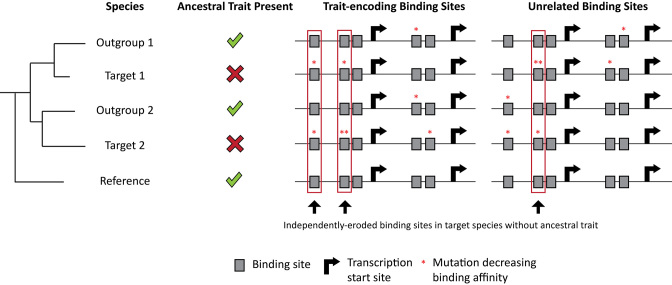Figure 1.
Given enough evolutionary time, independently eroded binding sites should congregate in genomic regions, which encode for independently lost traits. As species diverge, a phenotypic trait and the genomic regions required for that trait are inherited from the ancestral species. The trait of interest is necessary to maintain fitness, and therefore important trait-encoding transcription factor binding sites are under negative selection. As target species 1 evolves, a trait-loss event fixates within the species. However, the sister species outgroup 1 still maintains the trait. Since the trait is lost in target species 1, all trait-dedicated information now switches to neutral selection in the species. This leads to neutral erosion of trait-encoding transcription factor binding sites. Similarly, in target species 2, a trait-loss event (but not necessarily the same event as in target species 1) for the same trait fixates in the population. Here too, sister species outgroup 2 still maintains the trait. Now all trait-encoding information in target species 2 switch to neutral selection, and therefore the trait-encoding binding sites begin to neutrally erode. Using the sister species as outgroups, we can identify all transcription factor binding sites that have eroded in our target species but have been maintained in our outgroup species and many other references species. We refer to these sites as independently eroded binding sites. This very unusual evolutionary signature is shown in Figure 2 and Table 1 to be strongest next to key genes for the development of an important independently lost complex trait.

